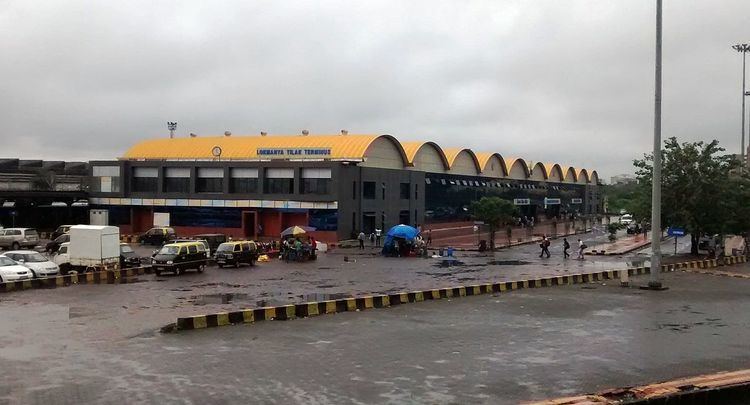Owned by Indian Railways Parking Available Elevation 7 m Connection Taxicab stand Platforms in use 5 | Operated by Central Railway zone Opened 1991 Phone 022 3266 2256 Owner Indian Railways | |
 | ||
Location Pipeline Road, Kurla, Mumbai, Maharashtra
India Connections Taxi Stand, Prepaid Auto service Structure type Standard on-ground station Address Pipeline Road, Mumbai, Maharashtra Similar Chhatrapati Shivaji Terminus, Kalyan Junction railway st, Bhusaval Junction railway st, Dadar railway station, Manmad Junction railway st | ||
Lokmanya Tilak Terminus (LTT), is a railhead in the Kurla suburb of Mumbai, India. LTT is managed by the Central Railway. The Kurla and Tilak Nagar suburban railway stations are located nearby. It is one of the railway terminals within Mumbai. The others being Chhatrapati Shivaji Terminus, Dadar on the Central Line, and Mumbai Central and Bandra Terminus on the Western Line.
Contents
- Indian railways 13201 rajendra nagar mumbai ltt janta express departing kalyan junction
- History
- Accessibility
- Dormitories
- Rainwater harvesting
- References
Indian railways 13201 rajendra nagar mumbai ltt janta express departing kalyan junction
History
Kurla Terminus situated in Kurla has been renamed to LTT. In 1996, the Brihanmumbai Municipal Corporation (BMC) approved a proposal to rename the station after Lokmanya Tilak, a popular leader of the Indian Independence Movement, and forwarded it to the Union Government through the Government of Maharashtra. Then Union Home Minister, Lal Krishna Advani approved the proposal in 1999, at the request of Ram Naik, the then Minister of State of Railway. After the decision was announced, Gurudas Kamat, the Lok Sabha member from Mumbai North-East, met L. K. Advani and submitted a memorandum asking that the terminus be renamed after Babasaheb Ambedkar.
In 2003, Central Railway (CR) decided to expand LTT to take on more rail traffic, as the Chhatrapati Shivaji Terminus (CST) had reached its saturation point, and was unable to handle any more express trains. In 2006, the Mumbai division of CR cleared the designs for construction of a swanky station complex to replace the dilapidated terminus complex. The new station complex design was prepared by the architect P. K. Das. The Mumbai Metropolitan Region Development Authority (MMRDA) also agreed to construct a ramp from LTT to the flyover to be built nearby, as part of the Santa Cruz – Chembur link road (SCLR). The revamped LTT was inaugurated on 16 April 2013 by Railway Minister Pawan Kumar Bansal. The revamp of the terminus took 3 years. The new station complex was built on 50,000 sq metre land and has a 3,300 sq metre concourse.
In October 2012, CR announced plans to cease long distance train services at Dadar within 5–6 years. The load would be transferred to LTT by upgrading the number of platforms at LTT from 5 to 12. CR plans to introduce connectivity with other modes of transport as well as build a mall, multi-storey parking, escalators, restaurants, food courts, better signage and indicators, budget hotels and an aesthetically pleasing exterior and interior. The project will be implemented on public-private partnership (PPP) mode and is expected to cost ₹50–60 billion. The project will be executed by the Railway Land Development Authority on the 20 acres of land that CR possess around LTT.
Accessibility
LTT is located in middle of two suburban railway stations, Tilak Nagar and Kurla, on the Harbour Line. It is easily accessible through Tilak Nagar railway station as a direct overhead bridge is made to LTT from Tilak Nagar. A share rickshaw service is available from Kurla railway station to LTT via level crossing. Average opening of the level crossing gate is 20 minutes.
Dormitories
Air-conditioned dormitories were inaugurated at LTT on 16 April 2013 by then Railway Minister Pawan Kumar Bansal. The dorm at LTT is a 24-bed AC dorm exclusively for women.
Rainwater harvesting
Central Railway (CR) completed installation of a rainwater harvesting system at LTT in October 2012. The system cost ₹1 million (US$15,000) and will conserve 700,000 litres of water, which is approximately 40% of the station's daily water requirement. The rainwater harvesting project will help in percolation of water into the subsoil, which will reduce flooding in the vicinity during monsoon. The project involved constructing a 2 km trench and filling it with crushed stones.
